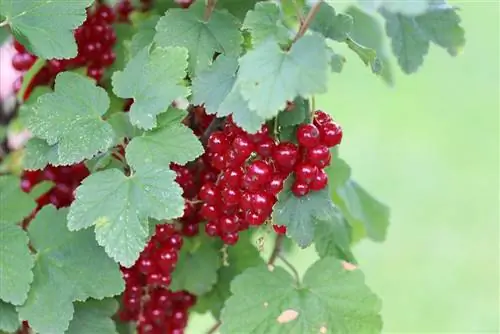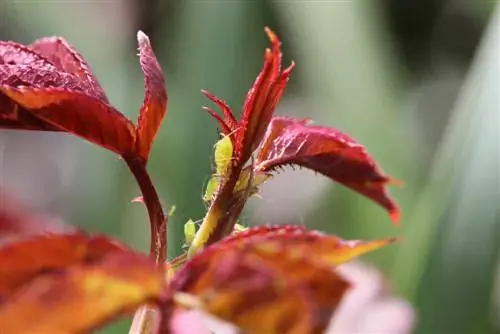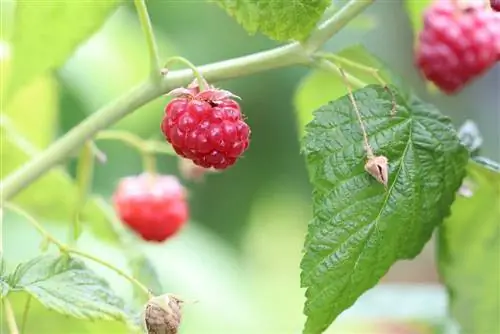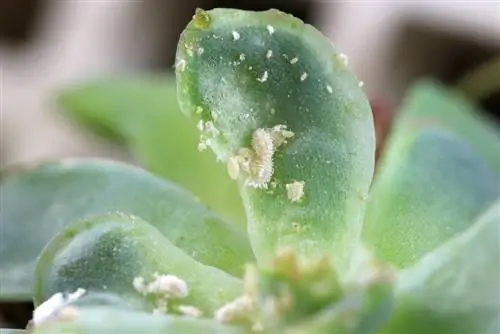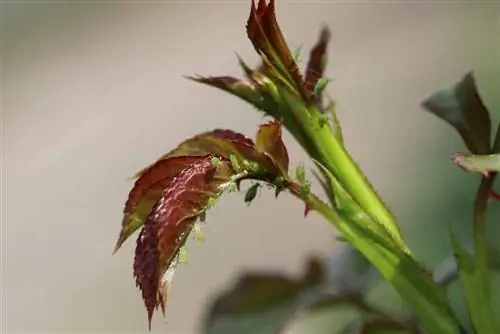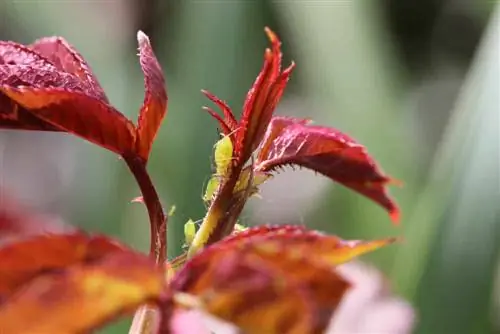- Author admin [email protected].
- Public 2023-12-17 03:39.
- Last modified 2025-01-24 12:45.
Aphids pose a danger to currants in home gardens. The pests suck out the leaves and thereby damage the shoots. In this way, an infestation with the voracious insects prevents a good harvest. To ensure successful control, shrubs should be examined regularly for the first signs. Natural home remedies are always preferred so as not to harm your own he alth or the environment.
malicious image
In the south of Germany, in Austria and in South Tyrol, currants are also called ribisel. The native shrubs are predominantly attacked by the bladder lice. These pests overwinter directly on the branches of the bushes, so they emerge along with the first leaves to emerge. Then the lice begin their harmful sucking activity, which in the event of a severe infestation can lead to the loss of the entire harvest. In summer the bladder louse changes its host and moves to herbaceous plants. In the autumn months, the voracious insects return to lay their eggs on the currants in the winter.
- Blister lice are green, size is only 2 mm
- Pests are often initially overlooked
- Infected leaves have curvatures
- Swelled bubbles form on the undersides of the leaves
- Lice are in the bubbles
- Red currants develop reddish discoloration
- White and black currant varieties have yellowish-green colors
- Sucking the juice from leaves and young shoots
- Then the plant cannot produce enough nutrients
Note:
Check currants regularly from spring to autumn for infestation, especially on the undersides of the leaves. Lice have often already settled there, even though there is no visible damage to the currant.
Home remedies for lice
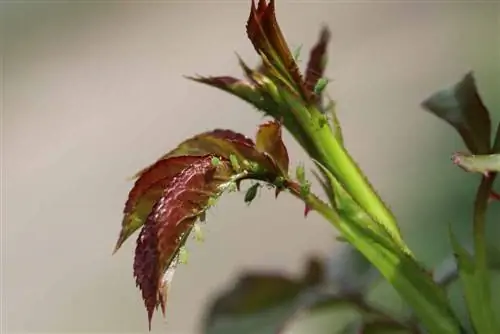
The easiest way to combat aphids is to collect and crush them by hand. However, this is only possible successfully if the infestation is still small and manageable. However, many people are disgusted by the pests and don't want to touch them. If the lice have already spread significantly, the affected shoots can be cut off. These plant parts must be destroyed in household waste to prevent re-infestation. Hosing down the affected areas with a strong jet of water has also proven to be helpful. However, the water jet should not hit the berries as this could damage them. In addition to these mechanical measures, various home remedies against aphids have proven effective. These products are harmless to human he alth and the environment. Various plants and products from the household are used.
Garlic broth
Aphids on currants can be effectively repelled with garlic. The popular seasoning tuber contains essential oils and exudes an extremely pungent smell. The pests feel repelled by this and stay away from the currant. In addition, the decoction can be prepared quickly and easily, so that control can be carried out promptly. Since the smell is very strong, the decoction should not be applied directly to the berries. Otherwise, their fruity flavor will be distorted in an unappetizing way.
- Take 50 g of fresh garlic
- Crushing toes with a knife
- Then boil 1.5 liters of water
- Douse your toes with it
- Then let it steep slowly for about three hours
- Next, strain through a tea towel
- Pour the cold brew into a bottle with a spray cap
- Spray the leaves of the affected plants with it
- Repeat every 7-10 days as a preventive measure
Manure from nettles
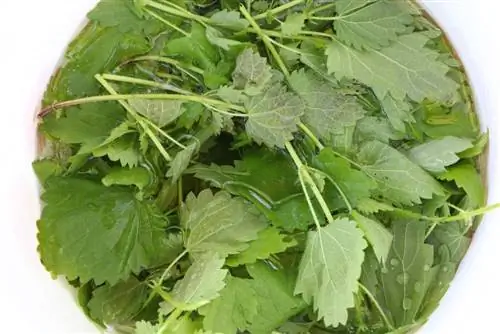
Our ancestors used a manure made from nettles as a biologically harmless home remedy to combat aphids. Both fresh and dry nettle leaves are suitable for production. Nettle extract has proven to be effective in normal to moderate infestations. After preparation, the manure should soak through well, but not yet start to ferment. In summer, the fermentation process starts quickly due to the warm temperatures, which is why the manure should be placed in the refrigerator during this time of year. If the mixture has started to ferment, this mixture can be used as fertilizer for the currants. In this way, the currant's immune system is strengthened, preventing aphid infestation.
- You need 200 grams of fresh nettle leaves
- Otherwise use 20 grams of dried leaves
- Roughly chop the nettles
- Let it steep in 1 liter of water for 2-3 days
- Then strain the mixture well and let it cool down
- Pour undiluted manure into spray bottle
- Spray affected areas with the mixture
- Repeat every few days
Tip:
In some cases the manure develops an unpleasant smell. This process can be weakened by adding a little rock dust.
Neem oil
Neem oil has its origins in Asia and has become established there in Ayurveda. The potent oil can be purchased in he alth food stores and he alth food stores. Due to its strong effects and intense smell, the oil should not be used undiluted. In the worst case, the currants could suffer damage as a result. Since the product has a strong effect, the aphids stop their activity after just a few hours after the first application. If neem oil is used repeatedly, the pests will completely disappear.
- Make a mixture of 1 teaspoon of neem oil with 1 liter of water
- Pour mixture into spray bottle
- Oil separates, so shake well before each use
- Spray affected areas once a day
- Use several times a day for very severe infestations
- Then repeat as a preventive measure every 7-10 days
Cord and soft soap
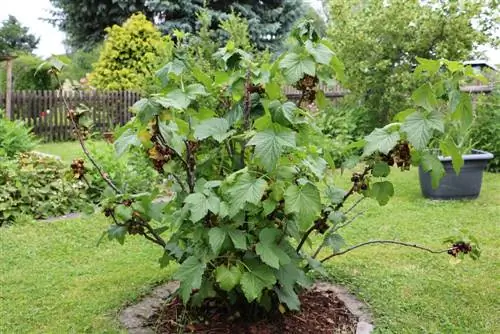
Cord and soft soaps have also become established in the fight against aphid infestations. There is no excess fat in these soaps, which is why there is no greasy layer on the sensitive currant berries after use. Since these natural soaps do not contain any artificial fragrances or colors, no synthetic thickeners are used in production. Liquid soap products and scented soaps are equally unsuitable as repellents because they contain strong fragrances and synthetic ingredients. If they were used, the flavor of the currants would deteriorate enormously.
- Organic soaps are ideal
- Approximately 25-50 grams are required
- Roughly chop the soap bar
- Then dissolve in 0.5-1 liter of lukewarm water
- Pour cooled soapy water into spray bottle
- Spray affected bushes, leave out berries
- Soap suds should not drip onto the ground
- Wash berries well before eating
Tip:
If there is an extensive aphid infestation, the effect of the soapy water can be increased by adding alcohol.
tansy decoction
An efficient spray against lice on currants can also be made from the leaves of the tansy. This strong brew is effective against all types of lice and can also be used for sensitive currants. Since this mixture is extremely high in potassium, it sustainably strengthens the shrubs' immune system. In this way, the plants become more resistant to infestation after application.
- 100 g fresh tansy leaves
- Roughly chop the fern
- Place in pot with 0.5 liters of water and cover
- Simmer the leaves at a low temperature for about 1 hour
- Then cool and strain the plant parts through a cloth
- Dilute the broth with an equal amount of water
- Then spray all affected plant parts
- Leave out the berries, otherwise the taste will be distorted
Soda

Baking soda is a home remedy with a wide range of uses and has also proven effective as an antidote for aphid infestations. The agent is also known as sodium bicarbonate and is not dangerous to people or the environment. Depending on the severity of the infestation, the dosage can be adjusted and reinforced with additional ingredients.
- Add 1 teaspoon of baking soda to 1 liter of water
- Dissolve by shaking
- If the infestation is very severe, add neem oil
- Alternatively fortify with alcohol
Broth from field horsetail
Field horsetail was already used by our ancestors to combat aphids. The local herb not only scares away aphids, it also strengthens the currant's immune system as a preventative measure. In this way, the bushes can better defend themselves against lice infestation. However, the broth made from field horsetails only works on mild infestations. If the aphids have already multiplied significantly, stronger home remedies are required.
- Use 1 kilogram of fresh field horsetail
- Use 200 grams of dry herbs as an alternative
- Soak in 2 liters of cold water for 1 day
- Spray the currants with the broth often
- Then carry out every week as a preventive measure
Oregano brew
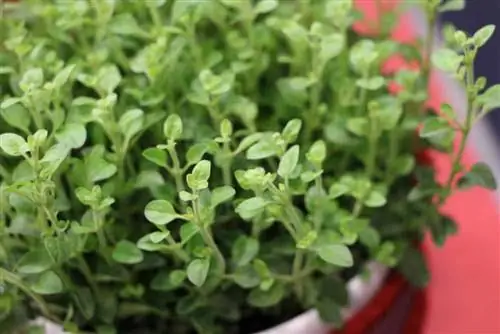
Oregano is a widespread culinary herb and, in addition to being used in cooking, is also suitable as an antidote for lice. Due to the essential oils, the pests are permanently driven away. Since the herb is used by most households, the home remedy can be made directly.
- Use either 100 grams of fresh oregano
- Otherwise use 10 grams of dried herbs
- 0.5 liters of water to the boil, pour over the oregano
- Let the broth steep for 15-20 minutes
- Then strain all plant residues through a cloth
- Then dilute with water in a mixing ratio of 3:1
- Let it cool down well, then put it in a spray bottle
- Use against pests every day

